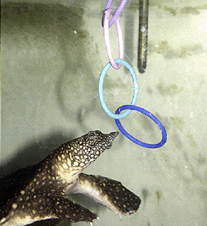The animal had an unusual-looking eye – I guess that’s why the practice had asked me to come and look at her. She had a really red conjunctiva and a hazy cornea, but it was still possible to see the pupil, which was neither dilated, suggesting glaucoma, nor constricted, alerting me to a uveitis. And the intraocular pressure was 18mmHg – within normal limits. Was the eye somewhat enlarged, or was it globe protrusion? An ultrasound scan seemed to show an area of echogenicity in the orbit, but then comparison with the other eye showed the same area in that retrobulbar space as well. Confusing!
I remember the radiologist who taught me some basics of ultrasonography back at vet school 35 years ago saying that unless you know what you’re doing, an ultrasound scan all too often looks like two white cats fighting in the snow. And while mostly I know what I’m looking at with an ultrasound image of the eye – there are only so many things that can be there in the globe itself – when it comes to interpreting what is happening in an abnormal orbit, I’m a bit lost. Maybe the animal needs to be referred to a specialist. But, wait a moment – I’m the ophthalmologist that the animal has been referred to! Talking to the owner, although the eye looks strange their pet isn’t in any discomfort, indeed doesn’t seem to have any behavioural issues, though vision is somewhat difficult to assess as by now the animal is becoming somewhat less than happy with this continued examination. Where do we go from here?
Unless you know what you’re doing, an ultrasound scan all too often looks like two white cats fighting in the snow
I give the owner my card and tell her to contact me if she notices any deterioration, while I promise to post pictures of the eye on my Instagram feed and ask my colleagues around the world on our ophthalmic ListServe what they think. And payment? Well, I suggested £50 as I haven’t been able to come up with a diagnosis. OK, I drove out to the practice, but I saw another two cases there, so that quite easily covered my costs. The owner was quite surprised – the practice that called me to see the case had charged her £300 the day before but similarly hadn’t been able to come up with a diagnosis, hence the referral to me. We could talk about the financial pressures of veterinary practice, I guess, but maybe a more interesting path is the problem of not being able to come up with a diagnosis.
I guess it’s easy for me: I can make a joke to the owner about having been doing this job for 35 years and still not being able to work out what was wrong with her pet’s eye. Or another case last week, again a good post on the Insta, was a dog with bilateral medial iris colobomas that I’d never seen before. I joked then that every day is a school day with new things turning up every so often, even after nearly four decades of seeing eyes. However, it’s a lot more difficult as a new graduate when you don’t know quite what you are seeing, but you still have to charge the owner. As I think I’ve written previously, it’s not so much a case of day one competence but day one confidence. The owner in that first case wasn’t so bothered about exactly what diagnosis I could come up with, how many scientific terms I could string together to explain what was going on in her animal’s eyes, but rather reassurance that the dog was not in discomfort.
We could talk about the financial pressures of veterinary practice, I guess, but maybe a more interesting path is the problem of not being able to come up with a diagnosis
Having said that, I often tell the owner that I may be an eye “expert” – though “ex” is past it and “spurt” is a drip under pressure (!) – but they are the expert on their pet. They may be holding the eye wide open in the consultation, or squeezing it tight shut as I try to examine it, but it’s only at home while they’re relaxing by the fire that it becomes apparent to the owner how the eye really is.
Teaching that sort of interaction between owner and vet can be quite tricky. Maybe it’s only with practice that this sort of confidence grows. How can we teach that in a class on client communications? The Cambridge Calgary model tells veterinary students of the importance of building rapport, involving the client in decisions about their animal, about non-verbal communication, and so on. But, to my mind, it’s only by seeing all this again and again in consultations while doing EMS that students see how things should be done – when consults go well and even when they go badly (or should I say less well!). That’s why reducing the number of weeks of doing clinical EMS is a mistake in my opinion. It’s only when you’ve shadowed a vet for a while and gained a rapport with them that you can discuss how a consult went, why that owner was angry and how best to console a client.
Last week, an owner was in pieces over her cat’s eye, even though I had said we could fix the problem. I instinctively hugged her, and she said she felt much better and was confident we could resolve the issue. It was only later, talking with the student who was with me, that I could voice why I thought that was the right thing to do. It is, I guess, a fair few years of dealing with owners in different situations that’s given me that gut feeling of what’s best to do. Thirty-five years of practice may not be enough to make my ophthalmic diagnostic skills perfect, but hopefully it’s given sufficient experience to cope with clients and their needs in most circumstances!










